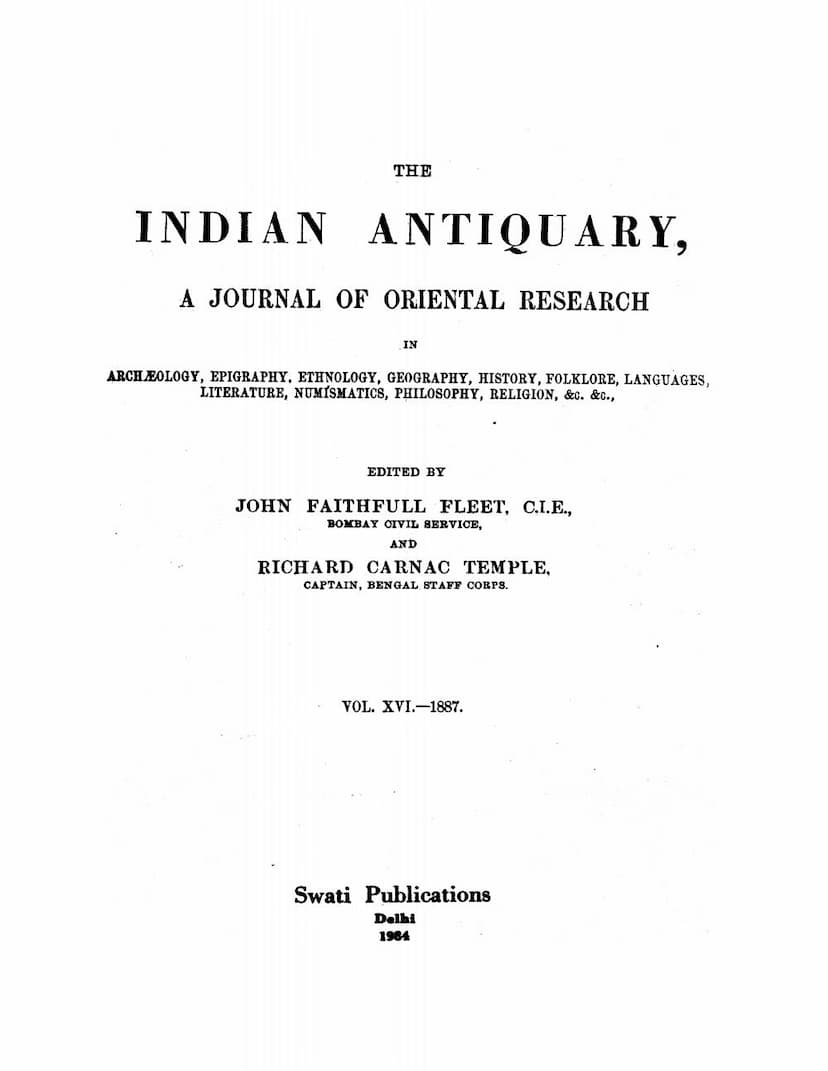Indian Antiquary Vol 16
Added to library: September 1, 2025

Summary
This document is the sixteenth volume of the Indian Antiquary, a journal of Oriental research, published in 1887 and later reprinted by Swati Publications. It contains a collection of articles on various aspects of Indian culture, history, and traditions, contributed by scholars like John Faithfull Fleet, Richard Carnac Temple, Professors G. Bühler, F. Kielhorn, and Pandit Bhagwanlal Indraji, among others.
The content covers a wide range of topics including:
-
Archaeology and Epigraphy:
- Several copper-plate grants are published and translated, providing insights into land grants, royal lineages, and administrative practices of various dynasties, such as the Sirpur copper-plate grant of Maharaja Rudradasa (p. 98), the Kauthem Plates of Vikramaditya V (p. 173), the Parla-Kimedi Plates of Maharaja Indravarman (p. 205), and the Banda District Plate of Madanavarmadeva (p. 208).
- The Asni Inscription of Mahipala (p. 173) and other inscriptions are discussed.
- A detailed examination of the "Dakhan in the time of Gautama-Buddha" (p. 1ff) by Rev. Thomas Foulkes, drawing from Ceylonese, Chinese, Burmese, Tibetan, and Indian sources, provides a comprehensive historical and geographical overview of the region during Buddha's era, mentioning cities, rivers, forests, and political states.
- The text includes discussions on the "Maurya passage in the Mahabharata" (p. 17) by Prof. R. G. Bhandarkar.
-
Numismatics:
- A coin bearing the name of Al-Adil al-Azim Chinghiz Khân and the Khalif An Nasir-i-din-ullah Amin-al-Mumunin is discussed in relation to Chinghiz Khan's interactions with local rulers (p. 134).
-
Folklore and Ethnology:
- A significant portion of the journal is dedicated to folklore from various regions of India, including Western India (No. VIII. Rání Jhajhans, p. 190; No. IX. Lalpari and Kevrâpari, p. 192), Southern India (No. XIV. The Monkey with the tom-tom, p. 81; No. XV. Good will grow out of Good, p. 195; No. XVI. Pride goeth before a Fall, p. 186; No. XVII. Light Makes Prosperity, p. 193), and Kashmiri tales (No. VIII. The Fish Taleed, No. IX. The Ogress Queen, p. 185; No. X. The Three Princes; No. XI. The Troublesome Friend).
- A comparative study of Asiatic symbolism is presented by H. G. M. Murray-Aynsley, exploring connections between Northern European and Asian customs and symbolism, including discussions on the Wild Huntsman, architectural customs, and the possible origins of Odin and the Wild Huntsman (p. 62ff, 195ff).
- The Gipsies in England and India are examined by G. A. Grierson, focusing on language and potential origins from Indian tribes like the Doms and Jats.
- An English-Gipsy Index compiled by Mrs. Grierson is included, serving as a linguistic resource.
-
Linguistics and Philology:
- Discussions on Bengali Literature and Nomenclature (p. 312).
- An analysis of the grammar of Sakatayana is provided by Prof. F. Kielhorn (p. 23).
- "Notes on the Mahabhashya" by Prof. F. Kielhorn delves into the grammatical authorities quoted and the text variations within Panini's work (p. 101ff).
- The language of the Magahiya Doms is discussed.
-
Religion and Philosophy:
- Remarks on the date of Sankaracharya, discussing various scholarly opinions (p. 160).
- A description of the Dakhan in the time of Gautama Buddha offers insights into religious practices, monasteries, and the spread of Buddhism.
- The Vasudeva and Gopichandana Upanishads are presented, with translations and notes by Col. G. A. Jacob (p. 287).
-
History and Social Customs:
- The journal contains an article titled "The Reign of Aryad Shah Durrani" (p. 263, 298).
- References are made to the "Progress of European Scholarship" in Germany, France, and Russia.
- "Discursive Contributions towards the Comparative Study of Asiatic Symbolism" by H. G. M. Murray-Aynsley explores architectural customs and potential links between European and Asian traditions (p. 10).
-
Calendrical and Astronomical Calculations:
- The journal features an article on "The Method of Calculating the Week-Days of Hindu Tithis and the Corresponding English Dates" (p. 118) by S. B. Dikshit.
- J. F. Fleet contributes an article on "A Lunar Fortnight of Thirteen Solar Days" (p. 81), and another on "The Scheme and Equation of the Years of the Gupta Era" (p. 141).
-
Book Notices:
- Reviews of several books are included, such as "Kavyamala" (p. 48), "The Uvasagadasao" (p. 78), "The Siddhanta-Kaumudi" (p. 80), "The Tarka-Kaumudi" (p. 112), and "Abhijnana-Sakuntala" (p. 344).
- The text also includes reviews of "The Sacred Books of China" (p. 140) and "Hunter's Indian Empire" (p. 228).
-
Miscellaneous:
- "Curiosities of Indian Literature" and "The Aryan Section at the Seventh International Congress of Orientalists held at Vienna" are also featured.
The journal also includes several illustrations, such as a church at Borgund, Norway (Plate 19), a Nepali Temple at Benares (Plate 20), a Peasant's Store-House at Bredland, Thelmarken (Plate 21), and sculptures from Tarragona Cathedral (Plate 22).
Overall, the Indian Antiquary, Vol. XVI, serves as a valuable historical document, preserving scholarly research on a wide array of subjects pertinent to the Indian subcontinent in the late 19th century. While not exclusively a Jain text, it contains articles that would be of interest to Jain scholars, particularly those focusing on the historical and cultural context of ancient India, and the dissemination of religious and philosophical ideas. The article on the Dakhan in the time of Gautama-Buddha, for instance, would shed light on the broader religious landscape of the period. The discussions on early literature and symbolism might also contain relevant material.